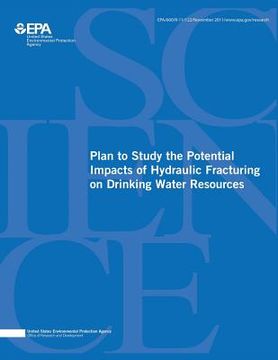Plan to Study the Potential Impacts of Hydraulic Fracturing on Drinking Water Resources
Synopsis "Plan to Study the Potential Impacts of Hydraulic Fracturing on Drinking Water Resources"
Natural gas plays a key role in our nation's clean energy future. Recent advances in drilling technologies-including horizontal drilling and hydraulic fracturing-have made vast reserves of natural gas economically recoverable in the US. Responsible development of America's oil and gas resources offers important economic, energy security, and environmental benefits. Hydraulic fracturing is a well stimulation technique used to maximize production of oil and natural gas in unconventional reservoirs, such as shale, coalbeds, and tight sands. During hydraulic fracturing, specially engineered fluids containing chemical additives and proppant are pumped under high pressure into the well to create and hold open fractures in the formation. These fractures increase the exposed surface area of the rock in the formation and, in turn, stimulate the flow of natural gas or oil to the wellbore. As the use of hydraulic fracturing has increased, so have concerns about its potential environmental and human health impacts. Many concerns about hydraulic fracturing center on potential risks to drinking water resources, although other issues have been raised. In response to public concern, the US Congress directed the US Environmental Protection Agency (EPA) to conduct scientific research to examine the relationship between hydraulic fracturing and drinking water resources. This study plan represents an important milestone in responding to the direction from Congress. EPA is committed to conducting a study that uses the best available science, independent sources of information, and a transparent, peer-reviewed process that will ensure the validity and accuracy of the results. The Agency will work in consultation with other federal agencies, state and interstate regulatory agencies, industry, non-governmental organizations, and others in the private and public sector in carrying out this study. Stakeholder outreach as the study is being conducted will continue to be a hallmark of our efforts, just as it was during the development of this study plan. The overall purpose of this study is to elucidate the relationship, if any, between hydraulic fracturing and drinking water resources. More specifically, the study has been designed to assess the potential impacts of hydraulic fracturing on drinking water resources and to identify the driving factors that affect the severity and frequency of any impacts. Based on the increasing development of shale gas resources in the US, and the comments EPA received from stakeholders, this study emphasizes hydraulic fracturing in shale formations. Portions of the research, however, are also intended to provide information on hydraulic fracturing in coalbed methane and tight sand reservoirs. The scope of the research includes the hydraulic fracturing water use lifecycle, which is a subset of the greater hydrologic cycle. For the purposes of this study, the hydraulic fracturing water lifecycle begins with water acquisition from surface or ground water and ends with discharge into surface waters or injection into deep wells. Specifically, the water lifecycle for hydraulic fracturing consists of water acquisition, chemical mixing, well injection, flowback and produced water (collectively referred to as "hydraulic fracturing wastewater"), and wastewater treatment and waste disposal.

